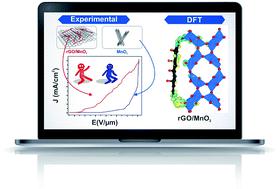Our official English website, www.x-mol.net, welcomes your
feedback! (Note: you will need to create a separate account there.)
Uncovering the origin of enhanced field emission properties of rGO–MnO2 heterostructures: a synergistic experimental and computational investigation
RSC Advances ( IF 3.9 ) Pub Date : 2020-7-10 , DOI: 10.1039/d0ra03360j Sachin R Rondiya 1 , Indrapal Karbhal 2 , Chandradip D Jadhav 3 , Mamta P Nasane 4 , Thomas E Davies 1 , Manjusha V Shelke 2 , Sandesh R Jadkar 4 , Padmakar G Chavan 5 , Nelson Y Dzade 1
RSC Advances ( IF 3.9 ) Pub Date : 2020-7-10 , DOI: 10.1039/d0ra03360j Sachin R Rondiya 1 , Indrapal Karbhal 2 , Chandradip D Jadhav 3 , Mamta P Nasane 4 , Thomas E Davies 1 , Manjusha V Shelke 2 , Sandesh R Jadkar 4 , Padmakar G Chavan 5 , Nelson Y Dzade 1
Affiliation

|
The unique structural merits of heterostructured nanomaterials including the electronic interaction, interfacial bonding and synergistic effects make them attractive for fabricating highly efficient optoelectronic devices. Herein, we report the synthesis of MnO2 nanorods and a rGO/MnO2 nano-heterostructure using low-cost hydrothermal and modified Hummers' methods, respectively. Detailed characterization and confirmation of the structural and morphological properties are done via X-ray Diffraction (XRD), Field Emission Scanning Electron Microscopy (FESEM) and Transmission Electron Microscopy (TEM). Compared to the isolated MnO2 nanorods, the rGO/MnO2 nano-heterostructure exhibits impressive field emission (FE) performance in terms of the low turn-on field of 1.4 V μm−1 for an emission current density of 10 μA cm−2 and a high current density of 600 μA cm−2 at a relatively very low applied electric field of 3.1 V μm−1. The isolated MnO2 nanorods display a high turn-on field of 7.1 for an emission current density of 10 μA cm−2 and a low current density of 221 μA cm−2 at an applied field of 8.1 V μm−1. Besides the superior FE characteristics of the rGO/MnO2 nano-heterostructure, the emission current remains quite stable over the continuous 2 h period of measurement. The improvement of the FE characteristics of the rGO/MnO2 nano-heterostructure can be ascribed to the nanometric features and the lower work function (6.01 and 6.12 eV for the rGO with 8% and 16% oxygen content) compared to the isolated α-MnO2(100) surface (Φ = 7.22 eV) as predicted from complementary first-principles electronic structure calculations based on density functional theory (DFT) methods. These results suggest that an appropriate coupling of rGO with MnO2 nanorods would have a synergistic effect of lowering the electronic work function, resulting in a beneficial tuning of the FE characteristics.
中文翻译:

揭示rGO-MnO2异质结构增强场发射特性的起源:协同实验和计算研究
异质结构纳米材料独特的结构优点,包括电子相互作用、界面键合和协同效应,使其对于制造高效光电器件具有吸引力。在此,我们报道了分别使用低成本水热法和改进的Hummers方法合成MnO 2纳米棒和rGO/MnO 2纳米异质结构。通过X 射线衍射 (XRD)、场发射扫描电子显微镜 (FESEM) 和透射电子显微镜 (TEM) 对结构和形态特性进行详细表征和确认。与孤立的MnO 2纳米棒相比,rGO/MnO 2纳米异质结构在1.4 V μm -1的低开启场、10 μA cm -2的发射电流密度方面表现出令人印象深刻的场发射(FE)性能。以及在3.1Vμm -1的相对非常低的施加电场下600μA cm -2的高电流密度。孤立的MnO 2纳米棒在10μA cm -2的发射电流密度下显示出7.1的高开启场,在8.1 V μm -1的施加场下显示出221 μA cm -2的低电流密度。除了rGO/MnO 2纳米异质结构优异的FE特性外,发射电流在连续2小时的测量期间保持相当稳定。 与孤立的α-结构相比,rGO/MnO 2纳米异质结构的FE特性的改善可归因于纳米特征和较低的功函数(氧含量为8%和16%的rGO为6.01和6.12 eV)根据基于密度泛函理论 (DFT) 方法的互补第一原理电子结构计算预测的 MnO 2 (100) 表面 ( Φ = 7.22 eV)。这些结果表明,rGO与MnO 2纳米棒的适当耦合将具有降低电子逸出功的协同效应,从而对有限元特性进行有益的调整。
更新日期:2020-07-10
中文翻译:

揭示rGO-MnO2异质结构增强场发射特性的起源:协同实验和计算研究
异质结构纳米材料独特的结构优点,包括电子相互作用、界面键合和协同效应,使其对于制造高效光电器件具有吸引力。在此,我们报道了分别使用低成本水热法和改进的Hummers方法合成MnO 2纳米棒和rGO/MnO 2纳米异质结构。通过X 射线衍射 (XRD)、场发射扫描电子显微镜 (FESEM) 和透射电子显微镜 (TEM) 对结构和形态特性进行详细表征和确认。与孤立的MnO 2纳米棒相比,rGO/MnO 2纳米异质结构在1.4 V μm -1的低开启场、10 μA cm -2的发射电流密度方面表现出令人印象深刻的场发射(FE)性能。以及在3.1Vμm -1的相对非常低的施加电场下600μA cm -2的高电流密度。孤立的MnO 2纳米棒在10μA cm -2的发射电流密度下显示出7.1的高开启场,在8.1 V μm -1的施加场下显示出221 μA cm -2的低电流密度。除了rGO/MnO 2纳米异质结构优异的FE特性外,发射电流在连续2小时的测量期间保持相当稳定。 与孤立的α-结构相比,rGO/MnO 2纳米异质结构的FE特性的改善可归因于纳米特征和较低的功函数(氧含量为8%和16%的rGO为6.01和6.12 eV)根据基于密度泛函理论 (DFT) 方法的互补第一原理电子结构计算预测的 MnO 2 (100) 表面 ( Φ = 7.22 eV)。这些结果表明,rGO与MnO 2纳米棒的适当耦合将具有降低电子逸出功的协同效应,从而对有限元特性进行有益的调整。











































 京公网安备 11010802027423号
京公网安备 11010802027423号